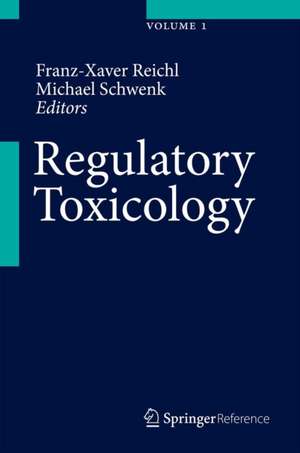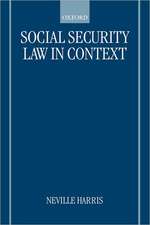Regulatory Toxicology
Editat de Franz-Xaver Reichl, Michael Schwenken Limba Engleză Hardback – 27 mar 2014
Preț: 3278.59 lei
Preț vechi: 3451.15 lei
-5% Nou
Puncte Express: 4918
Preț estimativ în valută:
627.34€ • 656.77$ • 519.10£
627.34€ • 656.77$ • 519.10£
Carte tipărită la comandă
Livrare economică 01-07 aprilie
Preluare comenzi: 021 569.72.76
Specificații
ISBN-13: 9783642353734
ISBN-10: 3642353738
Pagini: 996
Ilustrații: XXIV, 946 p. 144 illus., 70 illus. in color. In 2 volumes, not available separately.
Dimensiuni: 155 x 235 x 58 mm
Greutate: 1.68 kg
Ediția:2014
Editura: Springer Berlin, Heidelberg
Colecția Springer
Locul publicării:Berlin, Heidelberg, Germany
ISBN-10: 3642353738
Pagini: 996
Ilustrații: XXIV, 946 p. 144 illus., 70 illus. in color. In 2 volumes, not available separately.
Dimensiuni: 155 x 235 x 58 mm
Greutate: 1.68 kg
Ediția:2014
Editura: Springer Berlin, Heidelberg
Colecția Springer
Locul publicării:Berlin, Heidelberg, Germany
Public țintă
ResearchCuprins
Foreword.- Introduction.- Operation mode of regulatory toxicology.- Aims and institutions.- Aims and mission.- Application areas.- National and international collaboration.- Procedures and standards.- The regulatory process.- Quality assurance in regulatory toxcicology.- Toxicological risk assessment.- Methodological repertoire.- Toxicological tests.- Characterization of physicochemical parameters.- Examination of acute and chronic toxicity.- Examination of organ-toxicity and of laboratory parameters.- Specific tests for neurotox , immunotox, allergy, irritation, reprotox and carcinogenicity.- Toxicity testing in vitro.- New and future toxicological assays.- Computer-based prediction models.- Metabolism tests.- Toxicokinetic tests.- Toxicodynamic tests.- Omics.- International regulation for toxicological test procedures.- Data acquisition in humans.- Epidemiological methods.- Studies in volunteers.- Chemical analysis in toxicology (New).- Toxicostatistics and models.- Statistical evaluation methods.- Dose-response analysis, identification of threshold levels.- Extrapolation-procedures for carcinogenic and non-carcinogenic compounds.- Probabilistic methods.- Toxicodynamic models.- Toxicokinetic models.- Estimation of exposure.- Exposure analysis for indoor contaminants.- Exposure scenarios.- Use of toxiological data.- Quality criteria for primary literature.- Data-mining.- Paradigms use in risk evaluation.- Toxicological paradigms.- Do carcinogens have a threshold dose? pro and contra.- Single compounds vs combination effects.- Biomolecules vs smaller chemicals.- Sensitive humans vs average persons.- Assessment paradigmas.- Extrapolation factors and safety factors.- Background exposure vs additional exposure in human biomonitoring.- Adverse effects vs non-adverse effects.- ADI vs MOS principle.- Precaution principle vs hazard control.- Hygienic vs toxicological approaches.- Protected property and protection level.- Risk characterization and risk evaluation.- The riskconcept.- Current role of the term "risk".- Risk cycles.- Risk minimization in drug development.- Data required for risk evaluation.- Importance of physical-chemical properties.- Importance of intrinsic toxic properties.- Importance of metabolism and of mechanism of action.- Importance of the extrapolation to lower doses in risk assessment.- Importance of exposure level for risk assessment.- Risk characterization.- Risk assessment.- Elements of risk assessment.- Risk comparison.- Risk-benefit considerations.- Risk assessment in different jurisdictions.- Reach as a regulatory instrument (New).- Risk management and risk communication.- Risk management.- Purpose of risk management.- Assessment of limit values.- Deduction of limit values in different areas.- Registration and approval.- Classification and labelling.- Monitoring unwanted exposures and effects.- Restrictions and prohibitions.- Observance of susceptible population groups.- The toxicological expert report.- Risk management intoxicological emergencies.- Risk communication and participation of affected people.- Institutionalized participation.- The technique of risk communication.- Dealing with diseases that have been attributed to chemical exposures.- Addendum: tables and lists.- Checklist: Toxicological risk assessment in practice.- Glossary and risk terms.- Limit values, guideline values, tables.- Proposed additional chapters on Ethics in toxicology and expansion of the chapter dealing with Immunotoxicology.
Notă biografică
Franz-Xaver Reichl studied Microbiology and Medicine in Munich, Germany. He is Head of the Department of Dental Toxicology at the Department of Operative/Restorative Dentistry, Periodontology and Pedodontics, LMU Munich and Head of the International Advisory Centre for the toxicology and biocompatibility of dental materials. His field of research cover studies on cytotoxic, mutagenic, carcinogenic and embryotoxic effects of chemical compounds (e.g. dental materials) in human and animal cells, abrasion of composites and elution of dental composite components during the chewing situation in the chewing simulator MUC/3 and in vitro- and in vivo studies on toxicokinetic and toxicodynamic effects of chemical compounds (e.g. dental materials). He also work on studies on the pathways and on the analysis of intermediates in the metabolism of dental composite components in biological systems and risk assessments of xenobiotics (e.g. dental materials). Michael Schwenk studied Biochemistry and Medicine in Tuebingen, Germany. He then qualifiedas a toxicologist and pharmacologist and worked in universities, industry and a health agency. He initially focused on experimental cell toxicology, but later shifted to the measurement of chemical residues in humans and to study the health effects of such exposures in different populations. He was active in various national regulatory committees, advised the colleagues of the public health service of Baden-Württemberg and received practical experience in all major areas of regulatory toxicology.
Caracteristici
Experts from the various fields of regulatory toxicology have cooperated to produce a harmonized and up-to-date handbook Describes modern test systems, explains basic risk concepts and discusses the dogmas in the different regulation areas Provides a unique insight in the process of toxicological risk assessment, from cell to population Includes supplementary material: sn.pub/extras










